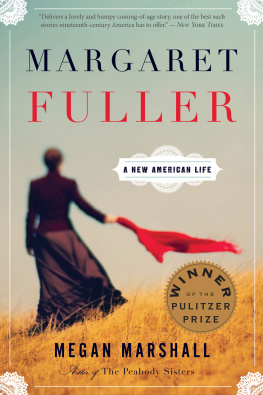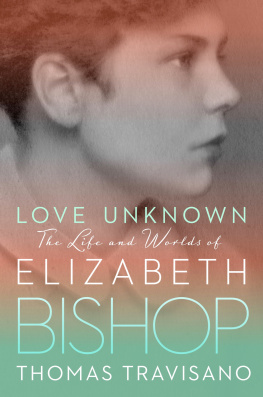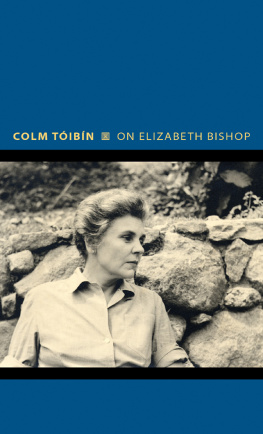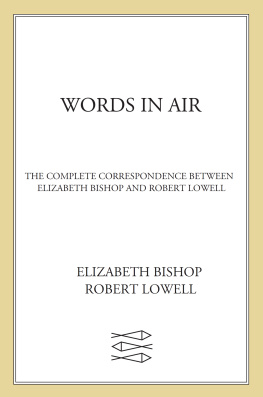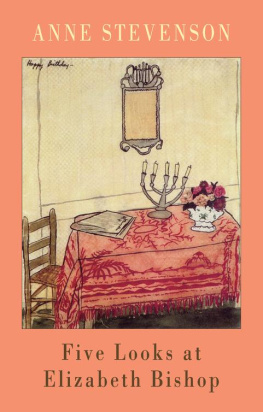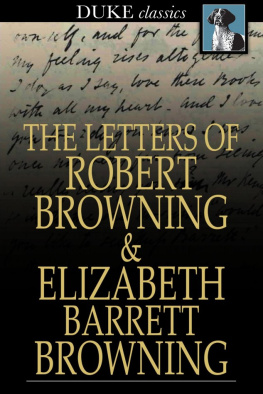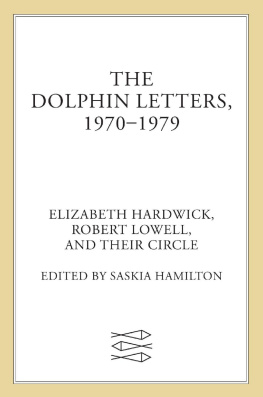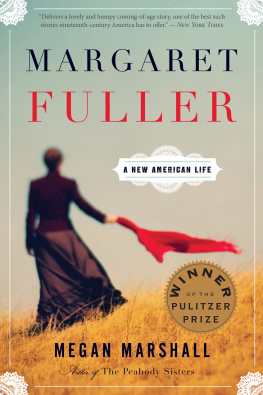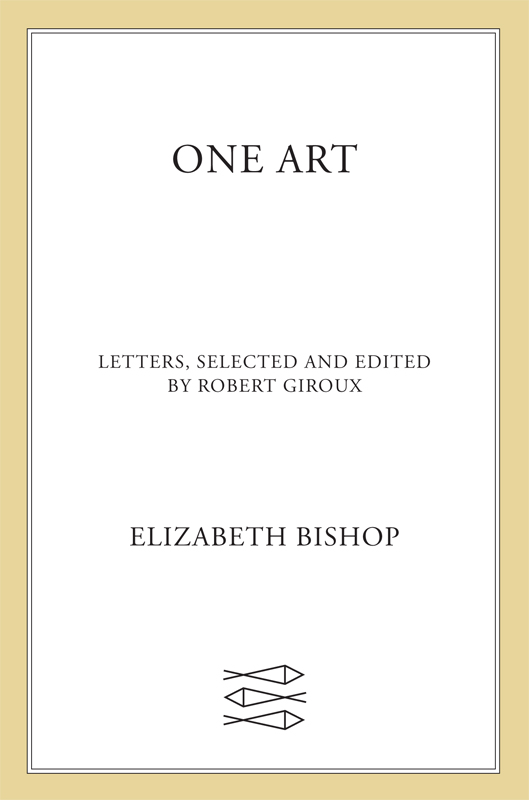Contents
Guide


The author and publisher have provided this e-book to you for your personal use only. You may not make this e-book publicly available in any way. Copyright infringement is against the law. If you believe the copy of this e-book you are reading infringes on the authors copyright, please notify the publisher at: us.macmillanusa.com/piracy.
Contents
SCHOOL, VASSAR, NEW YORK, EUROPE
KEY WEST, EUROPE, NEW YORK
North & South, MAINE, HAITI, YADDO, WASHINGTON
BRAZIL , A Cold Spring, SEATTLE , Questions of Travel, NEW YORK
SAN FRANCISCO, OURO PRTO, CAMBRIDGE , Geography III, NORTH HAVEN, LEWIS WHARF
BY ROBERT GIROUX
I
In a tribute to Elizabeth Bishop after her death, poet James Merrill cited her instinctive, modest, lifelong impersonations of an ordinary woman, an acute and witty observation about an extraordinary woman who is regarded as one of the major poets of our century. Richard Wilbur called her poems inexhaustibly fresh. Harold Bloom said her poetry stands at the edge where what is most worth saying is all but impossible to say. Octavio Paz wrote: The enormous power of reticencethat is the great lesson of the poetry of Elizabeth Bishop To hear it is not to hear a lesson; it is a pleasure, verbal and mental, as great as a spiritual experience. Frank Bidarta close friend of Elizabeth in her last years (to whom she left her library)has shown that her poetry also has a dark side since too often she has been considered cool and perfect, and not the profound, even tragic artist she is.
She once described her younger self as painfullyno, excruciatinglyshy. Only at the urging of her friend Robert Lowell, who recognized her genius early on, did she reluctantly agree to accept the post of Poetry Consultant at the Library of Congress, succeeding him and Lonie Adams in this office, known today as that of the Poet Laureate. Her sad and humorous letters around this period show that it was a lonely and difficult time for her.
During her life she wrote several thousand letters, from which the selection in this book has been made. The letters here cover fifty yearsfrom 1928, when she was seventeen (and already a poet), to her death in 1979and they represent only a fraction of her output. When Elizabeth Bishops letters are published (as they will be), Lowell predicted, she will be recognized as not only one of the best, but also one of the most prolific writers of our century. In a sense the letters constitute her autobiography, though they were not intended as such: she was not recording her life but was simply keeping in touch with her friends and correspondents. Inevitably, the details of her little known private life emerge in these pages. As one would have expected from so honest a nature as hers (the phrase is Richard Wilburs), she was explicit about the great love of her life, which lasted fifteen years and ended in tragedy. When accepting the Neustadt International Prize for Literature in 1976, she revealed in her biographical notes that for some fifteen years [I] shared a house in the mountains near Petrpolis and an apartment in Rio de Janeiro with a Brazilian friend, Lota Costellat de Macedo Soares. Part Four of this book covers their life in Brazil, beginning late in 1951 and ending with Lotas suicide in New York in 1967. Elizabeth describes her years in Brazil, before Lotas illness, as the happiest of her life.
* * *
One Art, the title of this book (taken from her villanelle), stands for the art of poetry, to which she devoted her life. William Butler Yeats believed that The intellect of man is forced to choose / Perfection of the life, or of the work, and Elizabeth chose the latter. Her meticulous striving for perfection in her verse is legendary, immortalized by Robert Lowell in his poem For Elizabeth Bishop 4: Do / you still hang your words in air, ten years / unfinished, glued to your notice board, with gaps / or empties for the unimaginable phrase / unerring Muse who makes the casual perfect? She started to write one of her most famous poems, The Moose, in 1956, promising her Aunt Grace she would dedicate it to her when it was ready; she mailed her the finished poem sixteen years later. The natural, unstrained language of this long, subtle, and marvelous poem, describing an interrupted bus trip from Nova Scotia, reads as if it had been written in one sitting. (Elizabeth was asked to read The Moose at the Harvard commencement in 1972 as the Phi Beta Kappa poem, and considered it a great compliment when a student who was asked what he thought of it said: Well, as far as poems go, it wasnt bad.)
One Art also stands for the art of letter writing, which she practiced more casually and with more prolific results than composing poems. She was not only a good letter writer herself, she enjoyed reading other peoples letters. Her library contained scores of books of lettersthe Elizabethans, George Herbert, Lady Mary Wortley Montagu, Jane Austen, Sydney Smith, Gerard Manley Hopkins, Oscar Wilde, Virginia Woolf, etc. Not many people know that she gave a seminar at Harvard on letter writing as an art. Limited to fifteen students, the course was listed in 197172 as English 2902. Conference Group: LettersReadings in Personal Correspondence, Famous and Infamous, from the 16th to 20th Centuries. She told a friend that the kind of letters and letter writers she had in mind for her class were Mrs. Carlyle, Chekhov, my Aunt Grace, Keats, a letter found in the street, etc.not only literary or formal letters, that is, but human and eloquent (even perhaps illiterate) ones, like those sent to her by Jimmy OShea of Fall River, aged seventy, when she briefly worked at a correspondence school after leaving Vassar (see her memoir The U.S.A. School of Writing).
She said that once, while staying with her friend the atomic physicist Jane Dewey, she wrote forty letters in a single day. This was the exception, of course; she usually complained of being behind in her correspondence. She wrote her close friend Mrs. Kit Barker: I am sorry for people who cant write letters. But I suspect also that you and I, Ilse, love to write them because its kind of like working without really doing it. Some letters are more carefully composed than others, like those to Marianne Moore and Robert Lowellespecially the one written in response to his recollected near-proposal of marriage. Her most spontaneous letters always display her famous eye for interesting or unexpected detailsof birds (like her beloved toucan, Uncle Sammy), animals (her cats antics), flora and fauna, and the behavior of children. There are a few cris de coeur, whose recipients were asked to burn or destroy them, but since the letters have remained extant, they are here. Letters like the one she wrote Robie Macauley (who had just moved into her Boston neighborhood and asked her about local stores), and the letter she wrote John Frederick Nims on the day she died (objecting to too many footnotes explaining words in her poems for students who could look them up and learn their meaning for themselves) are Elizabeth at her most characteristic as a letter writer.
I first met her in 1957 at the Cosmopolitan Club in New York, when we were drawing up a contract for her translation of The Diary of Helena Morley; I published this book and all her subsequent books of poetry. She was reserved and formal at the beginning, and also attractive and intelligent. Our mutual interests in poetry and music (especially opera; occasionally she was my guest at the Met), and the fact that for years I had known Marianne Moore and Robert Lowell, two of her closest friends, helped our publishing relationship deepen into a friendship that lasted until her death twenty-two years later. Her delightful poem Manners tells a great deal about Elizabeth: she always cherished, as well as practiced, good manners. Though highly sophisticated, she possessed at the same time a down-to-earth quality which perhaps came from her early upbringing in Nova Scotia. She not only had common sense and a superlative sense of humor, but enjoyed calling herself a country mouse, which made it easy to impersonate an ordinary woman. Among her many domestic gifts was that of being a superb and inventive cook (Lotas nickname for her was Cookie). She knew a great deal about painting, and excelled at watercolors, as the exhibit of thirty-seven of her drawings and sketches at the Key West Literary Seminar in January 1993 proved. When depressed she had trouble with drinking, but in all our years I never once saw her drunk. There are degrees of alcoholism, as any editor or publisher quickly learns. Despite books by writers (who never knew her) labeling her an addicted alcoholic, the letters show she was at times a heavy drinker, with a serious but not an all-consuming problem. After she took on her first teaching job (at age fifty-five), a professor wrote her, You are the soberest poet weve had here yet. Only an understanding of the whole cycle of her life provides the key to her character and genius.


